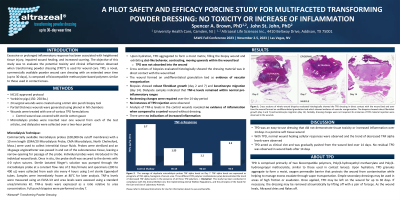Laboratory Research
(LR-002) Pilot Safety and Efficacy Porcine Study for Multifaceted Transforming Powder Dressing: No Toxicity or Increase of Inflammation

Excessive or prolonged inflammatory response has been associated with heightened tissue injury, impaired wound healing, and increased scarring. We report the evaluation of a novel commercial Transforming Powder Dressing (TPD) composed of a pair of biocompatible methacrylate-based polymers. TPD is a sterile powder that is applied directly to a moist wound surface. Upon hydration, TPD transforms into a non-occlusive barrier that seals and safeguards the wound, allowing for gaseous and fluid exchange while preventing bacterial infiltration. This study aimed to evaluate the potential toxicity and long-term inflammation associated with TPD using a porcine full-thickness wound model.
Methods:
Yorkshire pigs weighing between 150 and 250 lbs. were utilized in accordance with IACUC-approved protocols. Twenty-four surgical wounds were created using a 6 mm skin punch biopsy and subsequently treated with one of six different TPD formulations. Microdialysis probes were inserted near one wound from each formulation, and dialysates were collected over a two-hour period. TNF-α levels were measured using an ELISA kit. Urea levels were assessed using a standard urea/ammonia kit. TNF-α levels were expressed as a ratio relative to urea concentration. Full punch biopsies were performed on days 2, 7, and 14.
Results:
Upon hydration, the TPD material formed a moist matrix, filling the biopsy wound space. It exhibited clot-like behavior, contracting and moving upwards within the wound bed. Cross sections of biopsies evaluated histologically showed the dressing material in direct contact with the wound bed. The wound formed an undifferentiated granulation bed which showed evidence of vascular reorganization. Biopsies showed robust fibroblast growth (day 2 and 7) and keratinocyte migration (day 14), with dialysate samples showing TNF-α levels within the normal pro-inflammatory range. Dressing changes were not required. No instances of TPD rejection were observed. Analysis of TNF-α levels in the control wounds revealed no evidence of inflammation when compared to a control wound without dressing. There were no indications of increased inflammation.
Discussion:
The use of TPD effectively mitigated excessive inflammation and the formation of eschar, thereby promoting the wound healing process and demonstrated that all full-thickness wounds achieved complete healing without any clinical or toxic effects associated with the TPD polymers.
Trademarked Items:
References:

.png)